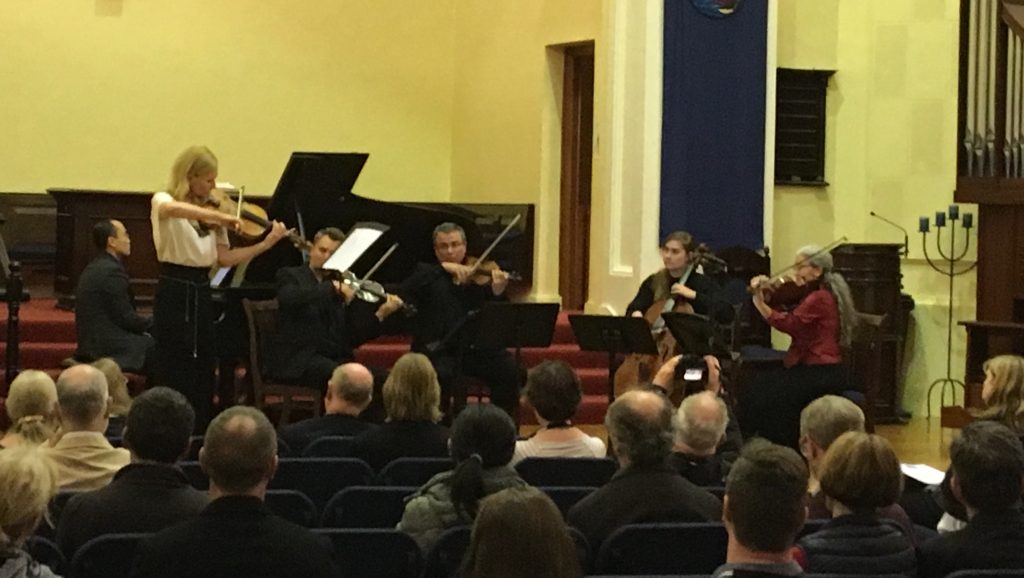Kristofer G. Skaug, DVS
The second day of the 44th International Viola Congress started with an early uphill battle against time and gravity to reach the campus of the Victoria University Wellington (VUW), which is the main venue for most Congress proceedings from here on out. At 8 o’clock sharp (!!), a surprising number of violists of all ages and nationalities gather for the first rehearsal of the Massed Viola Orchestra, conducted by Marcin Murawski. The repertoire is entirely dedicated to the oeuvre of Michael Kimber, a household name for anyone previously involved with viola ensemble playing. Classic titles such as the “Viola Fight Song“, “Three Quirky Little Pieces” and “I am Lost without my Beautiful Viola” (sic) are on the music stands. Considering the aforementioned variety of players, the first run-through went very well – and we have daily rehearsals until our performance on Tuesday afternoon! Donald Maurice has kindly lent me a viola from the faculty stores, as I didn’t have the guts to wager my own viola to the Wild West of carry-on luggage rules for this long trip.
The Congress itself resumed today with lectures and recitals in several halls of the New Zealand School of Music and the McDiarmid building. A central space is designated as showroom for luthiers, mostly from Australia and New Zealand.
My first visit went to a lecture with the captivating title “Dancing with Death: Shostakovich and Bartok’s Last Viola Works“. Natalie Stepaniak from the University of Northern Colorado had prepared a compressed presentation of this weighty topic. Unfortunately my head was not up to the task of absorbing this lecture at full speed at this time of the morning (if at all…).
Next up was a recital of repertoire for  Oboe, Clarinet and Viola: Violist Ames Asbell from Austin (Texas) brought two colleagues from orchestra to perform these works by (presumably American) composers such as Randall Thompson and Alvin Etler, ending up with the emotive “Three Armenian Impressions” by Michael Kimber.
Oboe, Clarinet and Viola: Violist Ames Asbell from Austin (Texas) brought two colleagues from orchestra to perform these works by (presumably American) composers such as Randall Thompson and Alvin Etler, ending up with the emotive “Three Armenian Impressions” by Michael Kimber.
For trivial reasons, I unfortunately missed the Midday Concert by Roger Myers, dedicated to the Bach family. Instead I was comforted by a catered sandwich lunch and a test drive of some of the showroom violas.
 Andrew Filmer’s lecture “No Museum Pieces: A Practical Take to the Grande Sestetto Concertante” blew away what was left of my regretful mood. He presented the anonymous transcription of Mozart’s Sinfonia Concertante for string sextet (downloadable for free here), demonstrating through various fragments (with score) how the Grande Sestetto can be used as a vehicle to get “buy-in” from violinists to learn this piece, by using it as chamber music repertoire rather than a Concerto. This should soften the learning curve and thus make the Concerto itself more frequently programmed in the future. Which is of course something that violists really want! The violin and viola solo parts have been attractively redistributed among the ensemble players (all except for the poor 2nd cellist), creating lots of enjoyable dialogues between these parts. Mr. Filmer also presented his own pragmatic adaptations to the sextet, in the form of ossia-solutions for awkward (originally viola) passages currently assigned to the 1st cello, basically letting the violas repossess those bits (smirk).
Andrew Filmer’s lecture “No Museum Pieces: A Practical Take to the Grande Sestetto Concertante” blew away what was left of my regretful mood. He presented the anonymous transcription of Mozart’s Sinfonia Concertante for string sextet (downloadable for free here), demonstrating through various fragments (with score) how the Grande Sestetto can be used as a vehicle to get “buy-in” from violinists to learn this piece, by using it as chamber music repertoire rather than a Concerto. This should soften the learning curve and thus make the Concerto itself more frequently programmed in the future. Which is of course something that violists really want! The violin and viola solo parts have been attractively redistributed among the ensemble players (all except for the poor 2nd cellist), creating lots of enjoyable dialogues between these parts. Mr. Filmer also presented his own pragmatic adaptations to the sextet, in the form of ossia-solutions for awkward (originally viola) passages currently assigned to the 1st cello, basically letting the violas repossess those bits (smirk).
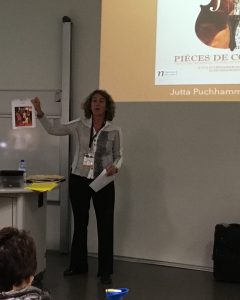 Jutta Puchhammer’s presentation “Pièces de Concours (1896-1938)“, constituted a well-deserved and well-used second chance for her to promote this work, after her initial effort at the Cremona congress last year fell victim to a freak schedule clash. She gave full evidence of a work of great dedication over the past several years to edit and publish a collection of rediscovered examination pieces commissioned by the Conservatoire de Paris from 1896 onward.
Jutta Puchhammer’s presentation “Pièces de Concours (1896-1938)“, constituted a well-deserved and well-used second chance for her to promote this work, after her initial effort at the Cremona congress last year fell victim to a freak schedule clash. She gave full evidence of a work of great dedication over the past several years to edit and publish a collection of rediscovered examination pieces commissioned by the Conservatoire de Paris from 1896 onward.
Not only has she created a prize-winning three-volume edition of the sheet music (which instantly sold out after her lecture), mrs. Puchhammer has also recorded all of these pieces herself on CD, conceding no quality compromises in her rendition of this exceedingly virtuosic music.
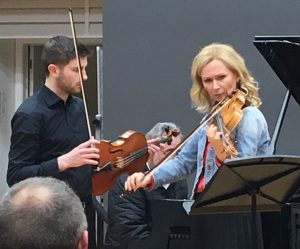
 In the Adam Concert Room of the School of Music, IVC44 featured artist Anna Serova gave masterclasses. I watched her coaching Henry Justo (Australia) in the Brahms Eb sonata, putting much emphasis on expression in vibrato and tonal quality. The 2nd student was Liudmila Kharitonova, probably by no total coincidence from Serova’s own home town of Arkhangelsk (Siberia). Her Allemande from Bach’s cello suite no.6 was already of great beauty from the outset, so it was fascinating to see Serova improve it further, in countless little details of bowing and phrasing.
In the Adam Concert Room of the School of Music, IVC44 featured artist Anna Serova gave masterclasses. I watched her coaching Henry Justo (Australia) in the Brahms Eb sonata, putting much emphasis on expression in vibrato and tonal quality. The 2nd student was Liudmila Kharitonova, probably by no total coincidence from Serova’s own home town of Arkhangelsk (Siberia). Her Allemande from Bach’s cello suite no.6 was already of great beauty from the outset, so it was fascinating to see Serova improve it further, in countless little details of bowing and phrasing.
I nevertheless decided to skip the 3rd and last student’s masterclass, in order to catch the lecture-recital on Chamber music for viola and bassoon: presented by former IVC36 host Nancy Buck of the University of Arizona together with French bassoonist Franck Leblois. At this point there were 3 parallel congress sessions running, and the Viola/Bassoon session unfortunately drew the short straw in terms of audience. Their loss!
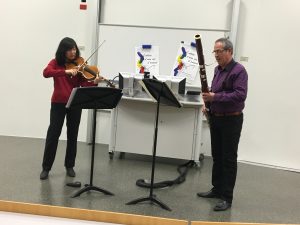 Kicking off with 8 duo’s (1995) by Philippe Hersant, a bassoonist-composer married to a violist; continuing with Comptes de Nuit (2008) by Swedish composer Eberhard Eyser: two pleasantly calm movements with a more lively middle section. The piece “Double Invert” (2016) by Ruth Matarasso explored different ways of bending out of a unison note, and had many other interesting effects including “multitonal” notes on the bassoon (raw and “imperfect” reed vibrations that one otherwise would discard as unwanted transients). The session concluded with a world premiere performance of the 3-part piece “AB” by a certain monsieur Petit, with an 18th century classical style first movement, followed by a calm movement and ending in a merry gallop. An inspiring presentation, begging the question why these 2 instruments don’t engage in duets more often!
Kicking off with 8 duo’s (1995) by Philippe Hersant, a bassoonist-composer married to a violist; continuing with Comptes de Nuit (2008) by Swedish composer Eberhard Eyser: two pleasantly calm movements with a more lively middle section. The piece “Double Invert” (2016) by Ruth Matarasso explored different ways of bending out of a unison note, and had many other interesting effects including “multitonal” notes on the bassoon (raw and “imperfect” reed vibrations that one otherwise would discard as unwanted transients). The session concluded with a world premiere performance of the 3-part piece “AB” by a certain monsieur Petit, with an 18th century classical style first movement, followed by a calm movement and ending in a merry gallop. An inspiring presentation, begging the question why these 2 instruments don’t engage in duets more often!
This evening’s “Potpourri” concert at St. Andrews offered a very comprehensive programme: Bruch’s 8 Stücke, a string trio, Mozart’s g minor quintet, followed by a Turina sextet and the Mendelssohn octet. Donald Maurice did his best to diminish the psychological challenge by suggesting we regard it as two separate, consecutive concerts. This mental trick almost worked for a good while.
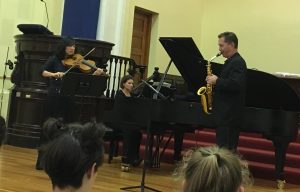 The Bruch pieces were special in that the clarinet had been replaced by saxophone, which worked very well. In some parts I felt that the saxophone was somewhat too expansive; but elsewhere it compensated with a richness in tone that is difficult to imagine from a clarinet. Again it was Nancy Buck taking care of the viola part, with Christopher Creviston on sax and Hannah Creviston at the piano.
The Bruch pieces were special in that the clarinet had been replaced by saxophone, which worked very well. In some parts I felt that the saxophone was somewhat too expansive; but elsewhere it compensated with a richness in tone that is difficult to imagine from a clarinet. Again it was Nancy Buck taking care of the viola part, with Christopher Creviston on sax and Hannah Creviston at the piano.
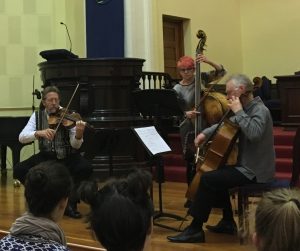 William Bolcom’s Fairytales trio for Viola, cello and Double bass is a highly original piece of music with a lot of temperament and humour. Kudos to the NZ Amazon trio (Peter Barber, Robert Ibell and Vicki Jones) for a very engaging performance.
William Bolcom’s Fairytales trio for Viola, cello and Double bass is a highly original piece of music with a lot of temperament and humour. Kudos to the NZ Amazon trio (Peter Barber, Robert Ibell and Vicki Jones) for a very engaging performance.
For obvious reasons, Mozart’s String Quintet no.4 in g minor (KV516) is regarded by many as the most 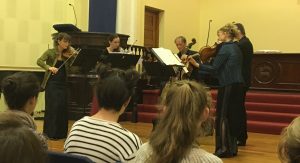 beautiful among his viola quintets. The opening theme alone is charming enough to melt a polar ice cap or two. The acclaimed New Zealand String Quartet, joined by Roger Benedict as the essential 2nd viola, gave a very warm and inspired rendition, concluding the first of the “two concerts”.
beautiful among his viola quintets. The opening theme alone is charming enough to melt a polar ice cap or two. The acclaimed New Zealand String Quartet, joined by Roger Benedict as the essential 2nd viola, gave a very warm and inspired rendition, concluding the first of the “two concerts”.
The “Second concert” started with Joaquin Turina’s Scène Andalouse for viola, piano and string quartet. The Deseret String Quartet hosted Anna Serova as solo violist and Jian Liu on the piano. Rich in moods, this piece flooded the last empty spaces in my head with warmth, and I spontaneously decided to call it a night. As for the Mendelssohn octet I left behind – fun as it may be – the prospect of hearing it while hanging upside down at a viola congress in New Zealand didn’t really add enough perspective for me to risk overkilling a wonderful day.

